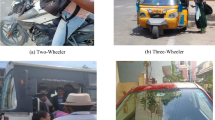Abstract
Indian traffic being heterogeneous in nature exhibits an anomalistic lane discipline. This uncertain distribution of vehicles is not only positioned longitudinally but also positioned laterally. Lateral movement of the vehicle has so far not received due attention though it possesses potential liability for the frequent occurrence of risky vehicular interaction between the lanes. Lane changing is an important vehicle maneuvering that particularly depicts the lateral movement of vehicles on the road. Safe and secure driving can be ensured by studying the driver’s judgment while interacting with the neighboring vehicles across the lane and determining the voids present in the driver’s perception of safety and thereby bridging the gap with the suitable measure. With this in concern, an attempt was made in this present study to observe, comprehend and to interpret the driver’s behavior in laterally moving vehicles. To carry out the study, the data was been collected from 2 locations K.R. Puram and Ramurthy Nagar ring road in Bengaluru city by static traffic recording technique. Video recording was done by drone surveying at these locations. The data obtained from the recorded video are analyzed to study the variation in lateral acceleration with correlation with road geometry and vehicle types, lateral gap maintenance and acceptance behavior. The average lateral acceleration of auto is 0.66 m/s2, two-wheeler is 0.72 m/s2, bus is 0.63 m/s2, LCV is 0.69 m/s2. This study of driver’s behavior acknowledges the fact that the two-wheeler users exhibit a risky lateral interaction with the average gap of 0.42 m maintained between bike users leaves them in a tight spot and with the raising lateral acceleration, the chances of collision are higher. The lateral deviation parameter was found to be higher in case of car exhibiting an average deviation of 6.69% and followed by two-wheelers with average deviation of 5.45%. The lower lateral clearance value with increase in lateral deviation of the vehicles indicates the absence of lane discipline and unsafe driving behavior.
Access this chapter
Tax calculation will be finalised at checkout
Purchases are for personal use only
Similar content being viewed by others

References
Choudhury C, Ramanujam V, Ben-Akiva M (2008) A lane changing model for urban arterials. In: Proceedings of the 3rd international symposium of transport simulation, Gold Coast, Australia
Santel G (2010) Lateral driving behaviour. In: Proceedings of 10th Swiss transport research conference, ETH Zurich, Monte Verita, pp 1–26
Gunay B, Erdemir G (2011) Lateral analysis of longitudinal headways in traffic flow. Int J Eng Appl Sci 3(2):90–100
** S, Wang D, Yang X (2011) Non-lane-based car-following model with visual angle information. Transp Res Record J Transp Res Board 2249:7–14
Maurya AK (2011) Comprehensive approach for modelling of traffic streams with no lane discipline. In: Proceedings of conference on models and technologies for intelligent transportation systems, Leuven, Belgium, pp 36–40
Sreekumar M, Maurya AK (2012) Need for a comprehensive traffic simulation model in Indian context. In: Proceedings of international conference on emerging frontiers in technology for rural area, pp 13–18
Metkari M, Budhkar A, Maurya AK (2013) Development of simulation model for heterogeneous traffic with no lane discipline. Procedia-Soc Behav Sci 104:360–369
Mathew TV, Munigety CR, Cherian A, Ostawal A (2014) A space discretization based simulation approach for non-lane based traffic conditions. In: Proceedings of Transportation Research Board 93rd Annual meeting, No. 14–3854
Author information
Authors and Affiliations
Editor information
Editors and Affiliations
Rights and permissions
Copyright information
© 2022 The Author(s), under exclusive license to Springer Nature Singapore Pte Ltd.
About this paper
Cite this paper
Dilipan, T., Das Vivek, R., Parthan, K. (2022). Study of Driver’s Behavior for Lateral Moving Vehicles. In: Maurya, A.K., Maitra, B., Rastogi, R., Das, A. (eds) Proceedings of the Fifth International Conference of Transportation Research Group of India . Lecture Notes in Civil Engineering, vol 219. Springer, Singapore. https://doi.org/10.1007/978-981-16-8259-9_17
Download citation
DOI: https://doi.org/10.1007/978-981-16-8259-9_17
Published:
Publisher Name: Springer, Singapore
Print ISBN: 978-981-16-8258-2
Online ISBN: 978-981-16-8259-9
eBook Packages: EngineeringEngineering (R0)



